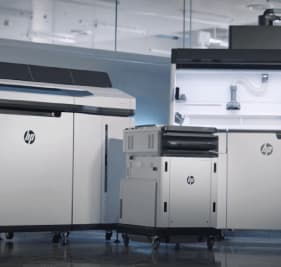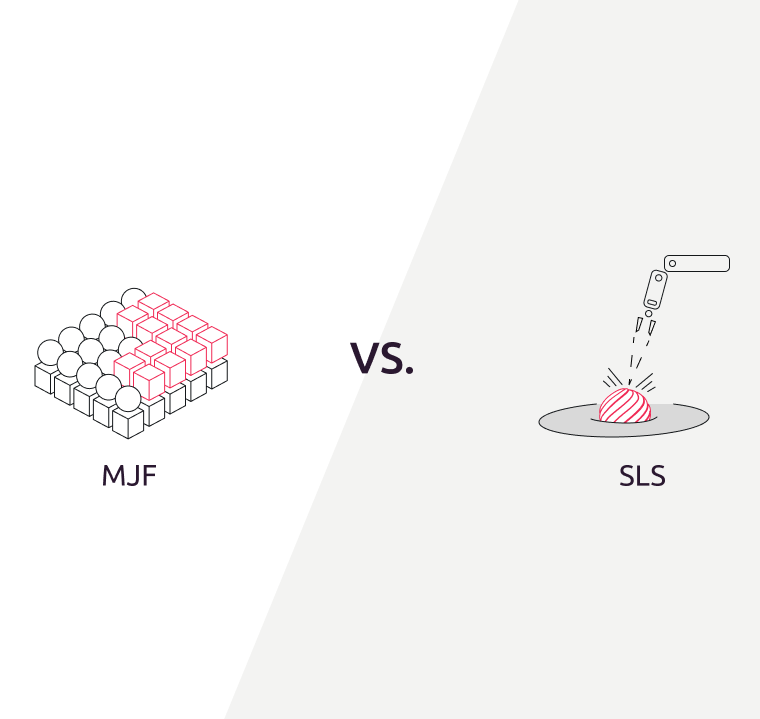Top 5 reasons to use Multi Jet Fusion 3D printing
Serial 3D printing production can be very time-consuming. To produce large batches, you need press molds and casting, but press molds take months to manufacture and cost tens of thousands of dollars. Then there’s the fact that casting just can’t be done for all products, for example, architectural models or hinged joints.
This problem is solved by MJF technology which enables the fast, high-resolution, and low-cost printing of products, even ones that can’t be cast. In this article, we will go through, in detail, five key advantages of this technology.
What is MJF printing?
Generally, 3D printers are just seen as devices that squeeze out melted polymer to make plastic products layer by layer. And this is in fact how FDM technology works. MJF printers, on the other hand, work differently. The printing process is very simple. The first layer of polyamide is applied to the base. It is then coated with a binder. Then the printer applies infrared light to the entire layer. Some powder, coated with the binder, sinters. Then the printer adds another layer of polyamide, and the process is repeated. The product is made layer by layer until complete.

Once finished, the item is taken out, cooled, and cleaned. If necessary, it can also be polished and painted.
MJF (Multi Jet Fusion) is a unique powder 3D printing technology from Hewlett-Packard. To manufacture items, industrial printers sinter PA12 polyamide with infrared light. This substance was made especially for 3D printing. The technology and printing material enable the production of dense high-resolution products with a smooth surface. Finished products are moisture-proof, resistant to ultraviolet light, thermal, and mechanical influences.
The MJF technology production uses the industrial printing line: a 3D printer and a station for cooling, cleaning, and post-processing.
Top 5 reasons to choose MJF
MJF technology is of equal quality to casting, it produces high-resolution products, it uses durable and biocompatible material, it is high-speed, and available to everyone.
It is an effective alternative to casting. Casting is most commonly used in the serial production of detailed plastic products. This requires the creation of a press mold and then filling it with the melted polymer. It is a fast-production method with high repeatability.
However, press molds take months to manufacture and cost tens of thousands of dollars. Then, if the model prototype needs refinement, another press mold has to be made, which costs valuable time and money.

MJF printing enables the prompt and cheap creation of prototypes, as well as, their testing and refinement. After that, you can start serial production.
Not all products can be cast, though, and this is where MJF technology shines as it can create even complex constructions, for example, hollow or hinged-joint items as well as products with airways and ducts. You can even print a detail within a detail. Casting and extrusion printing (FDM technology) simply can’t accomplish this task.
MJF provides the same consistent quality as casting. For example, HP Jet Fusion 5210 prints models with a 1200 DPI resolution. The minimum layer thickness is 80 microns, which is the same width as that of a human hair. So, you can use MJF to print a batch of completely identical items.

Durable material. We use powder PP (polypropylene), TPU (Thermoplastic polyurethane) HP 3D High Reusability PA 12 polyamide, which was made especially for MJF technology. With it, finished products can withstand high temperatures and its melting point is +187°C. The material is resistant to lubricants, aliphatic hydrocarbons, and alkaline conditions. The polyamide is also ultraviolet-resistant, which means it can make items for outside use.

PA 12 meets all European and American biocompatibility and fire safety requirements. The powder contains neither heavy metals nor phthalates. It is even used for making toys.
Fast printing. MJF is a fast 3D printing technology. For comparison, in three hours, metal extrusion can print 36 identical items, with laser sintering 79 items can be printed, whereas, in the same time-frame MJF allows you to produce 1,000 detailed items.

MJF technology is so fast because the heating element used covers the entire print area and all details are printed simultaneously.
This technology is available to all. The Ukrainian company Infomir designs and produces prototypes and products using an HP Jet Fusion 5210 printer. We accept orders from startups, 3D print studios, and manufacturers of medical equipment, and more.

Anyone can order something to be 3D printed by Infomir. To do this, upload the automatic cost calculation model and send your request.
How to prepare a model for MJF printing
Firstly, you will need a 3D model. To create it, use a computer-aided design system (CAD). 3D models are usually designed in such programs such as Maya, SolidWorks, ZBrush, Blender, and Autodesk 3ds MAX.
Every printer has its own print area—a chamber where items are made. Before uploading the model, make sure it does exceed the dimensions of the print area.
Once that is done, you must check the model for inconsistencies and compliance with the printing requirements: minimal wall thickness, minimal face angles, minimal splits, and hole diameter. You can check this in CAD.
The then-ready 3D model is uploaded into the slicing software. This is required to receive the printing command. The software slices the model to create layers and the printing algorithm. The next stage is the printer preparation.
Please read the list of MJF technology requirements to prepare 3D models for printing within our guidelines.
The printer’s reservoir is then filled with the PA 12 polyamide powder, and the equipment preparation ends.
Printed samples
Infomir’s capacities allow you to check the product design to save money on casting. A lot of Ukrainian companies already use Infomir’s services. For example, Orthos clinic orders printed jaw models. These products are used for creating individual teeth aligners.
For the company Eleks, Infomir prints voltage regulator frames. Prototypes are manufactured within a couple of days, and the customer receives products ready to test, saving huge amounts of time.
MJF technology enables the printing of any items: mock-up models, functional parts, medical prostheses, and anatomical models. Come and take a look at some of the finished products made with our printer. Models can be found on the Infomir 3D Printing page on Instagram.


